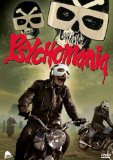Nicky Henson plays Tom, the leader of a hellraising biker gang known as the Living Dead. His goal is to make that moniker absolutely literal, and it helps that his mother (Beryl Reid) is a medium who has made some sort of Satanic pact, and the butler (George Sanders, in his final role just before his suicide) might well be an infernal power himself (his precise nature is never made clear). At any rate, all it takes to come back from the dead, apparently, is to kill oneself while firmly believing that one will return. Tom proves this formula to be correct, and soon almost all the other gang members follow suit. The one member who might hold out is his girlfriend Abby (Mary Larkin). Meanwhile, as the Living Dead embark on a reign of terror, will anyone be able to stop them?
This is a pretty odd duck of a film, and quite delightful for precisely that reason. In the first place, the Living Dead are hardly the most threatening biker gang ever to grace the silver screen, and though they do rack up quite the body count of policemen and civilians, many of their other bits of misbehaviour are not so much atrocities, but more in the line of shenanigans (as a fellow viewer aptly put it, the gang don’t become flesh-eating zombies, only unkillable twits). The precise nature of Reid’s motivation is never made clear, Abby is so whiny and callow that one is hard-pressed to feel any sympathy for her, and there’s this strange preoccupation with the idea of the frog as an embodiment of evil. But these very oddities contribute to, rather than detract from, the film’s off-kilter entertainment value. There’s a wealth of incident, so the viewer is never bored, there are some very fun chase scenes, and (which is a good thing) there is a rather knowing sense of humour about the whole affair. Definitely one of the odder horror films to emerge from England in the 1970s, and an engaging rediscovery.
Video
The original negative of the film has, it seems, been lost, and so this release has done what it can (and done very well indeed) with a complete 35mm print. There are some limitations, then, and some visible aging: the grain is noticeable, there is some damage, and the colours aren’t always perfect. But I mention perfection as a way of indicating that, for the most part, the colours look really good, with strong contrasts, and great blacks, flesh tones and reds. My previous experience of this film was as an EP VHS, and the difference is night and day, not to mention the fact that the presentation is in 1.78:1 anamorphic widescreen. All in all, I don’t think we could hope for a better looking transfer than what we have here. This is a sharp, quite impressive restoration.
Audio
Some age here, too. The volume fluctuates a little bit, and the sound isn’t always perfectly clear. But again, perfection isn’t a realistic goal, and the sound is really pretty solid. This is especially true of the score – extremely 70s and most delightful. The ballad “Riding Free” must be heard to be believed (“they tried to clip his wings just like a fly”). The overall sound is quite warm and full, and quite satisfactory.
Special Features
Return of the Living Dead: (25:02) Cast members Nicky Henson, Mary Larkin, Denis Gilmore, Roy Holder and Rocky Taylor are interviewed, and they all have quite the collection of anecdotes. This is a great feature, as cheerful as it is informative.
The Sound of Psychomania: (9:04) Composer John Cameron dredges up his memories of the film, and like those of the cast, they are both fond and self-deprecating. More fun.
Riding Free: (6:26) Now it’s singer Harvey Andrews’ turn, and he has no more illusions about the film than does anyone else, especially when it comes to that mind-boggling song he had to record (which was then badly mimed in the film itself) but he’s a great sport, and even plays part of the song at the end.
Introduction by Fangoria Editor Chris Alexander: (5:28) A very good idea to watch first, as Alexander sets the right party tone for watching this little piece of celluloid madness.
Theatrical Trailer.
Final Thoughts
Is the film a classic? Of course not. But one will note the obvious pleasure with which everyone involved recalls the film, and that pleasure is infectious. Get a big crowd of cult film nuts together, and you’re in for a fine evening.





